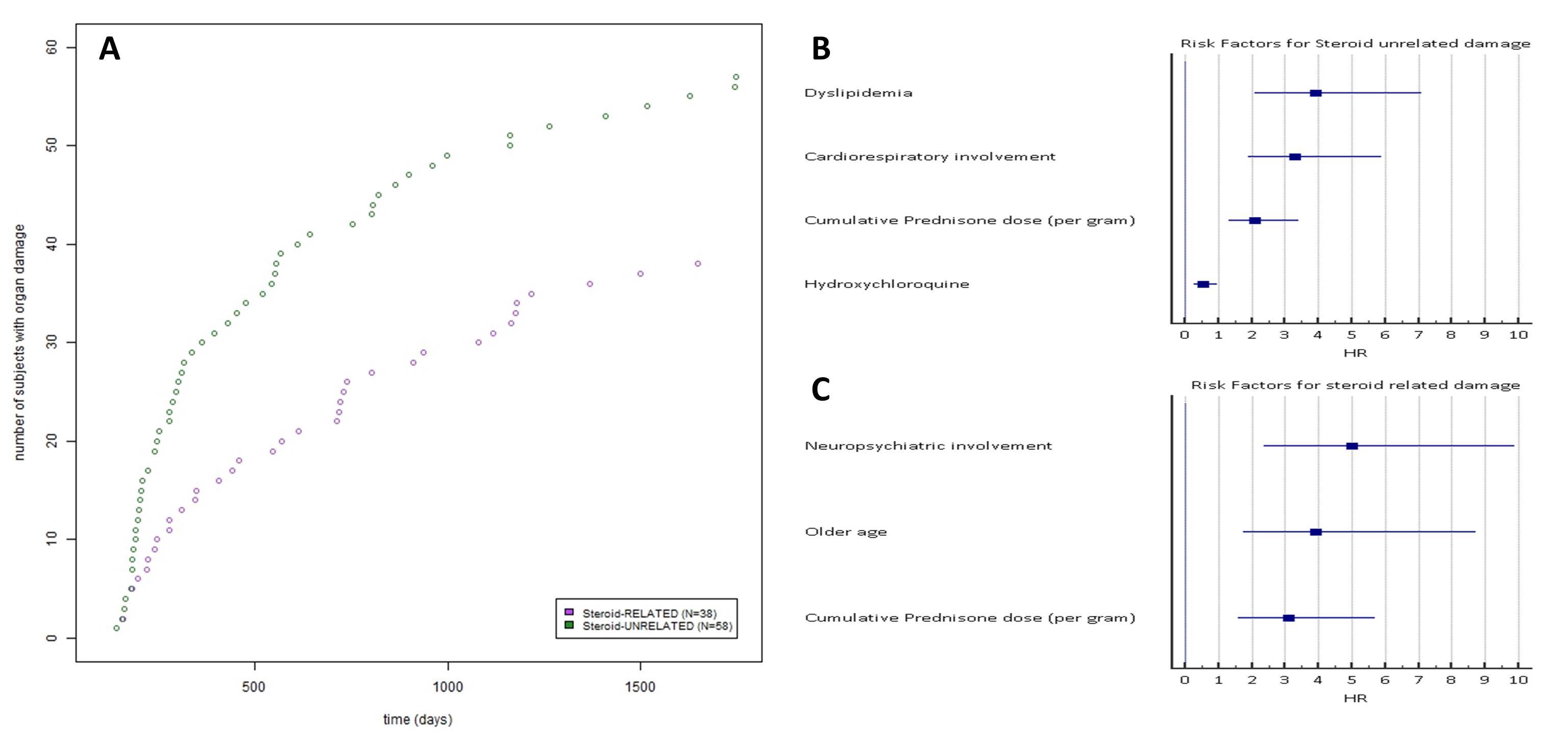Session Information
Date: Tuesday, October 23, 2018
Title: Systemic Lupus Erythematosus – Clinical Poster III: Treatment
Session Type: ACR Poster Session C
Session Time: 9:00AM-11:00AM
Background/Purpose:
Preventing organ damage is a major challenge in Systemic Lupus Erythematosus (SLE).To evaluate factors associated with development of steroid-related and unrelated damage in an inception cohort of early diagnosed SLE patients.
Methods:
The Early Lupus Project encompasses 9 Italian centers recruiting consecutive patients diagnosed within 12 months of SLE (1). At enrolment and then every 6 months a panel of data (including demographic, comorbidities, serologic, clinic by BILAG2004 domains, ECLAM, HRQoL by visual analogic scale and treatment) was recorded.
Using univariate analysis, we assessed the contribution of covariates collected at baseline in development of steroid-related and not-related damage categorized according to previous definition (2) and assessed by the SLICC/ACR Damage Index (SDI from 0 to ≥1). Forward-Backward Cox-regression models were fitted with covariates with p<0.05 to identify factors independently associated with increased risk of damage development.
Results:
Overall, 279 patients were enrolled in the Early Lupus Project inception cohort up to the 31th of December 2017; 230 patients (89.6% Caucasians, 13.4% males) were eligible for this study having SDI=0 at enrolment and at least 6 months of follow-up. Age (mean ± SD) at diagnosis was 36.5 ± 14.4 years, the median interval between diagnosis and recruitment was 1.1 months (interquartile range 0.0-4.8) and median follow-up was 27.4 months (interquartile range 7.2-48.0).
At last follow-up visit 84 patients (36.5%) had an SDI score ≥1 (median = 0; interquartile range 0-1); 38 of them (16.5%) developed steroid-related damage and 58 (25.2%) developed steroid-unrelated damage. Figure A shows the kinetics of damage development.
Factors independently associated with increased risk of developing steroid-related damage were baseline neuropsychiatric involvement (p<0.001; HR 5.0 95% CI 2.3-10.6), older age (p=0.001; HR 3.9 95%CI 1.8- 8.7) and cumulative prednisone dose (p<0.001; HR 3.1 per 10 grams; 95%CI 1.6-5.7) were (Figure B). Factors independently associated with increased risk of steroid-unrelated damage accrual were baseline dyslipidemia (p<0.001; HR 3.9 95% CI 2.1-7.1), cardiorespiratory involvement (p<0.001; HR 3.3 95% CI 1.9-5.9), and cumulative prednisone dose (p<0.001; HR 1.0001 per 10 grams; 95%CI 2.1-3.4),whereas hydroxychloroquine reduced the risk of steroid-unrelated damage (p=0.041; HR 0.53; 95%CI 0.29-0.98) (Figure C).
Conclusion:
The risk profile for damage development in this early SLE cohort differs for steroid-related and unrelated damage. Addressing modifiable risk factors, adding hydroxychloroquine since the very early stages and treating disease activity to target remission or minimal disease activity, may reduce damage and improve patients outcome.
1. Sebastiani GD, et al. Lupus. 2015;24:1276-82.
2. Gladman D, et al. J Rheumatol 2003;30;1955-1959
To cite this abstract in AMA style:
Piga M, Sebastiani GD, Prevete I, Iannone F, Coladonato L, Govoni M, Bortoluzzi A, Mosca M, Tani C, Doria A, Iaccarino L, Tincani A, Fredi M, Conti F, Spinelli F, Galeazzi M, Bellisai F, Zanetti A, Carrara G, Scirè CA, Mathieu A. Different Risk Profiles for Development of Steroid-Related and Steroid-Unrelated Damage in Early Diagnosed SLE: Results from the Italian Multicenter Early Lupus Project Inception Cohort [abstract]. Arthritis Rheumatol. 2018; 70 (suppl 9). https://acrabstracts.org/abstract/different-risk-profiles-for-development-of-steroid-related-and-steroid-unrelated-damage-in-early-diagnosed-sle-results-from-the-italian-multicenter-early-lupus-project-inception-cohort/. Accessed .« Back to 2018 ACR/ARHP Annual Meeting
ACR Meeting Abstracts - https://acrabstracts.org/abstract/different-risk-profiles-for-development-of-steroid-related-and-steroid-unrelated-damage-in-early-diagnosed-sle-results-from-the-italian-multicenter-early-lupus-project-inception-cohort/

